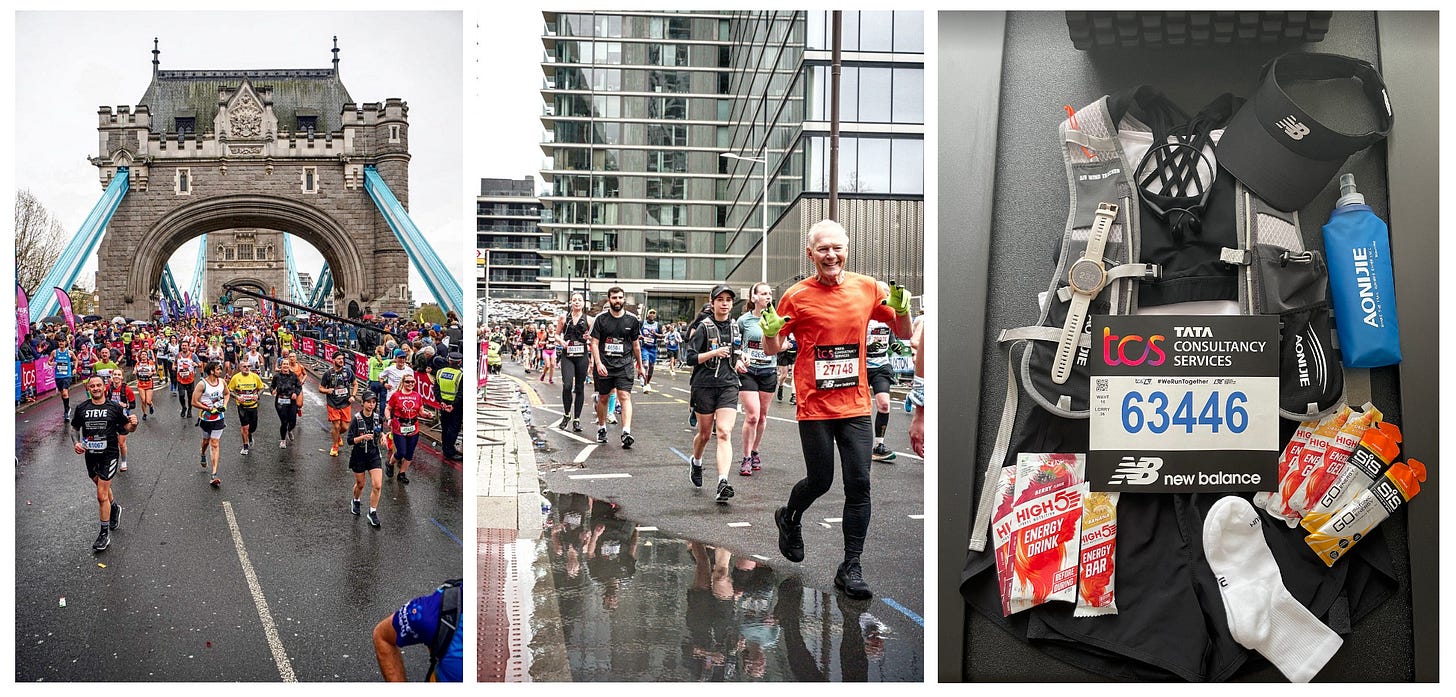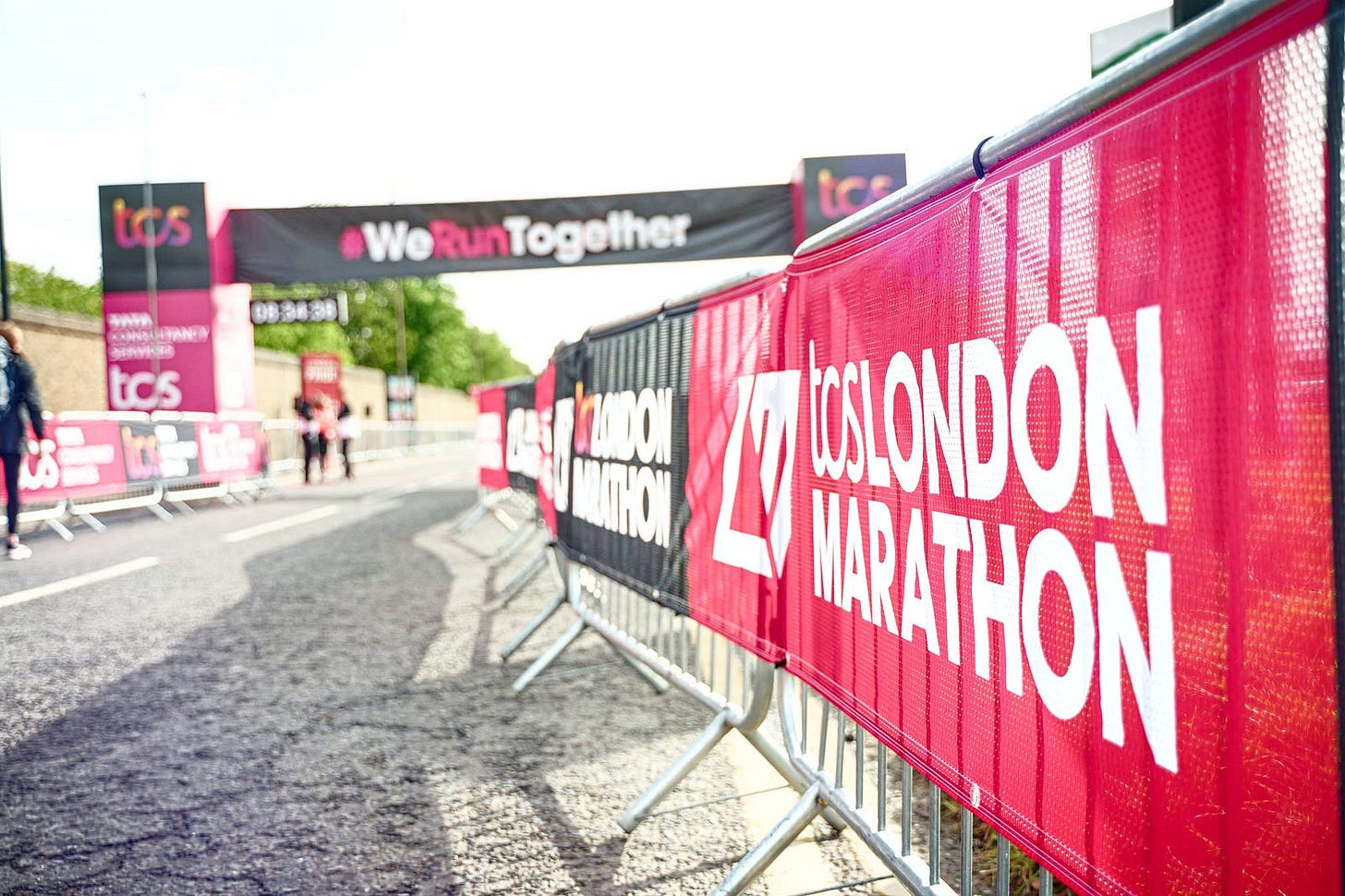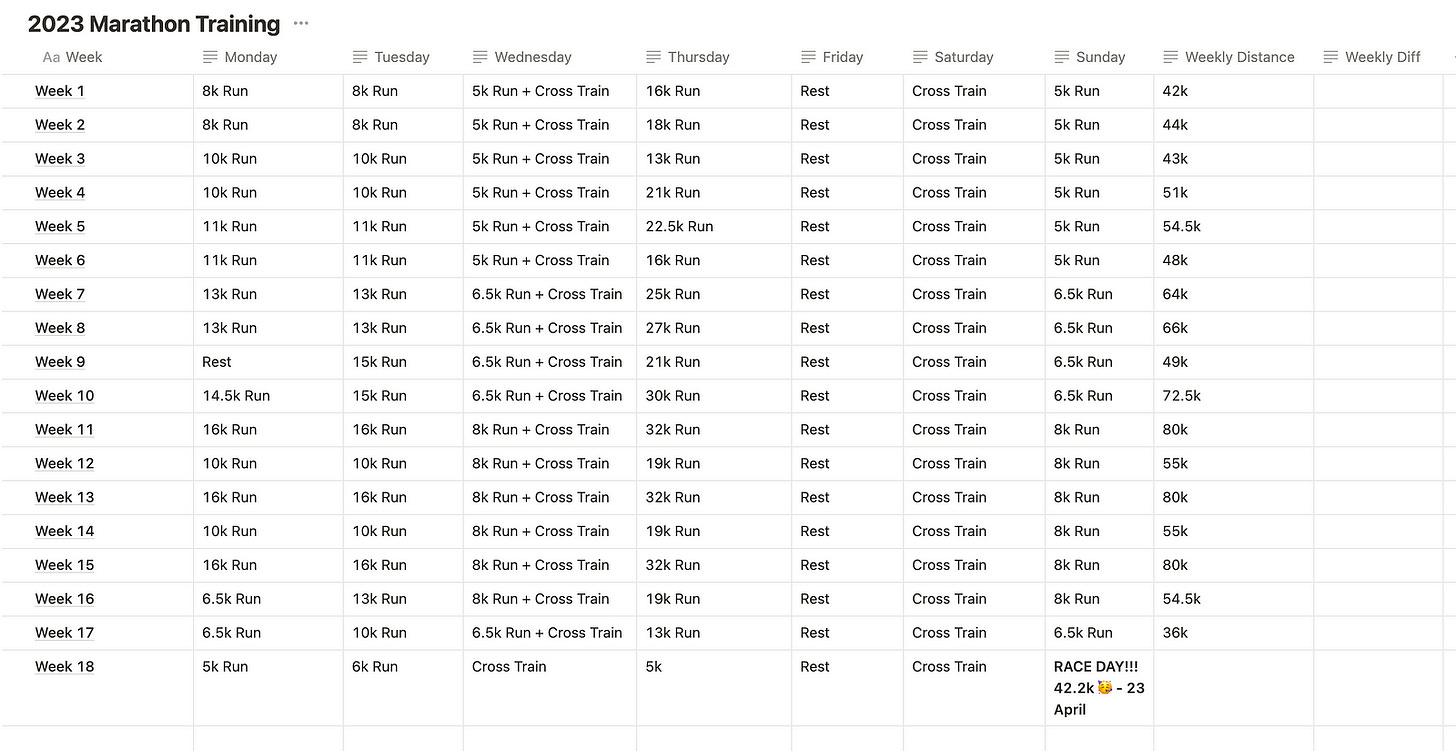The 'Lazy-to-Crazy' Runner's Guide to Marathon Glory
On the sustainable journey of consistently pushing yourself

NB: This is part of the once in a while non-technical edition.
As I watch the New York marathon coming to an end, I can’t stop being jealous of the runners conquering their 42k distance for the first time. The euphoria, the pride, the joy, the relief and then the complete exhaustion.
So how do people transition from being an intermittent short distance runner to finishing their first marathon? This article will list a couple of points that helped me run my first London Marathon.
Just to note, these suggestions come from a runner who attempted her first marathon. In my case, pace wasn’t the goal but getting to the finish line was. So the following might not be suitable for someone wishing to finish on a good time. Mine was 4h59min.
Build a strong foundation
Ensure you can comfortably complete a 5K race without significant struggle. Start from here and then slowly increase your weekly mileage. A 5k is a manageable distance for most runners and serves as an excellent foundation for building endurance. If you can comfortably run a 5k, you’ve already established a base level of cardiovascular fitness and leg strength. This makes transitioning to longer distances, like a marathon, more achievable.
Always prioritise the basics — sleep, stress-free lifestyle, nutrition, hydration, minerals and electrolytes.
Sleep plays an important role for regulating your hormones, including those that affect your appetite and energy levels. A proper sleep schedule will help you keep your hunger and energy cravings in check, allowing you to maintain a balanced diet and good energy levels for training. Another important process that happens during sleep is that your body enters into recovery mode, repairing and rebuilding muscles that have been stressed during training. This is when you become stronger and more resilient.
Stress, whether it’s from work, personal life, or other sources, can contribute to physical tension and muscle tightness. This can interfere with the body’s ability to recover after long training runs or intense workouts. A relaxed and stress-free state promotes better physical recovery.
Proper nutrition ensures that your body has an adequate supply of carbohydrates, fats, and proteins to fuel your workouts and support overall energy levels. Furthermore, after intense training sessions, your muscles need to repair and recover. Nutrition plays a vital role in this process, providing the necessary nutrients to rebuild muscle tissues and reduce post-exercise soreness. Proper nutrition includes maintaining adequate fluid and electrolyte balance. Staying hydrated is essential for endurance and preventing dehydration-related issues like heat exhaustion or heat stroke. Marathoners rely on glycogen stores in the muscles and liver to maintain energy levels during long runs. Nutrition, particularly carbohydrate intake, helps replenish glycogen stores, ensuring you have the necessary energy reserves.
Electrolytes are lost when seating, so make sure to hydrate. Sodium and chloride are lost in high concentrations, while potassium, magnesium and calcium are lost in lower concentrations.
Create a training plan
Find a reputable marathon training plan that suits your fitness level. Plans typically span 12–20 weeks and include long runs, tempo runs, and recovery days. A good plan should be tailored to suit each runner’s experience and lifestyle. When I trained for the London Marathon, this is how mine looked like:
Consistency through discipline
Another aspect that cannot be stressed enough. Stick to your training schedule. Avoid skipping workouts and maintain regularity. Pace is not important, just get the distance done. Consistency in training improves mental toughness. The ability to stick to a training plan and complete scheduled runs, even on challenging days, strengthens your mental resilience. This mental toughness is invaluable during the latter stages of a marathon when fatigue sets in.
Cross-training
Include cross-training activities like cycling or swimming to prevent overuse injuries which can serve as a form of active recovery on your rest or low-intensity days. Low-impact activities can help you maintain cardiovascular fitness without putting additional stress on your running muscles. I intercalated sessions of cycling and strength training during my weekly workouts.
Rest and Recovery
Rest allows your muscles to recover and repair, reducing the risk of overuse injuries, giving your body a chance to heal minor aches and pains before they develop into more serious injuries.
Race Simulations
Participate in other races during your training period. Simulate the race conditions, including nutrition and hydration. Try out the gels you’re going to use during the race day.
Prioritise the weekly long run
Long runs should be done at a comfortable and sustainable pace. This will help you build endurance and will promote the development of your aerobic system, improving your body’s ability to use oxygen efficiently to produce energy for extended periods.
Prepare mentally
Develop the mental toughness to handle the physical and mental challenges of a marathon. Divide and conquer, split the distance you want to run into smaller chunks. Run the first chunk, and then the other. A good playlist can have a tremendous help as well.
Enjoy the ride, celebrate the small achievements
Training for a marathon is a long and demanding process. Celebrating small achievements provides motivation to keep going. When you acknowledge your progress, you’re more likely to stay committed to your training plan. Celebrating small milestones reinforces positive behavior. When you recognise and celebrate your efforts, it reinforces the habit of consistent training.
Tapering
Reduce your training load in the weeks leading up to the marathon to ensure you’re well-rested and injury-free.
Race Day Essentials
Plan for race day logistics, including transportation to the event and pre-race nutrition. Have all your gear ready, including your race bib, timing chip, and clothing.

While the training plan sounds like something that will get boring in the long run, running shouldn’t be another thing you do on top of your daily chores, so make it fun! Run on hills, run on track, use a treadmill, do short runs, long runs and everything in-between. Running shouldn’t hurt, and some days the best run is no run. If your week of runs looks like a playlist with the same song by the same artist 17 times in a row, well then you’ll have to mix things up, to turn each week into an epic playlist.
Running shouldn’t be about getting a PB. It should be about learning to love your body during its good and bad days. Some days it should be about pushing yourself, learning to have the resilience to stick with it when times get hard and slowly learning the impact of having consistency through discipline. And some other days it should be about learning to listen to your body, give it a rest and appreciate it for everything it has done for you. Running is about being mindful and getting closer to the nature. It has proven to me so many times by now, how amazing are those small moments we tend to miss in our daily hectic busy lives — the chilly air and sound of crunchy leaves on a cold autumn morning, the golden hour and warm breeze on a sunny summer afternoon.
So if you decide to join the 42k challenge, don’t forget that the most important part is to enjoy the process.



